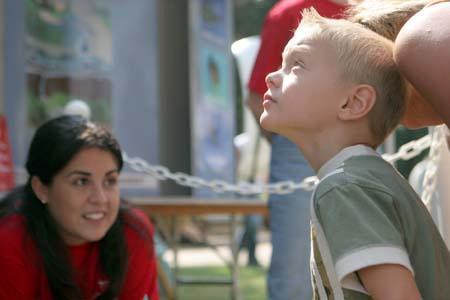James Shuler gets excited about insects.
Although the junior in elementary education said he learned a lot about them in his Insects and People class, he said it was also where he heard about BugFest.
But the event, the nation’s largest single-day bug event and the most widely attended N.C. Museum of Science special event, taught Shuler another reason to love bugs.
Their taste.
“Last year, they had lollipops with an insect in the middle. I had one of those,” he said. “I also had hush grubbies, insect biscuits and chocolate covered insects. Those, you really can’t really taste the bugs at all. The hush grubbies are my favorite.”
During his second trip to the annual event, held Saturday, Shuler said he plans to take full advantage of it.
“I love it,” he said. “I’m excited this year because I have more time to look at stuff.”
Cafe Insecta, where Shuler could indulge in the bug buffet, had one of the longest lines of any exhibit and although BugFest also offered concessions such as hot dogs and ice cream, the insects were the top choice for many attendees.
“It’s really good food,” Gary Krontz said.
Krontz, his wife and his two young sons, were all eating food they picked out from Cafe Insecta. This year marked the sixth trip to Raleigh for BugFest for the Krontz family.
But crunching on insects wasn’t the only exhibit that drew attention.
A crowd of children stared spellbound at another attraction, Jim Alberti, ringmaster of the Alberti Flea Circus, as he played his street organ before his performance. Once he began, the crowd grew and the children sat quietly, waiting to see the tiny creatures do their tricks.
Alberti said his family has been in the flea circus business since the late 1800s — beginning in England and then moving to the United States.
At the beehive demonstration called “The Amazing Bee Beard,” a volunteer sat inside a cage; keeping most, but not all, of the bees away from bystanders. The instructor tied a small wooden box — enclosing the queen bee — to the woman’s neck.
Then, the instructor placed a large piece of cardboard, used as a ramp, leading up toward the box. He pushed the bees up the ramp as they walked along, moving them finally into position — making a moving and buzzing beard around the volunteer’s mouth. She sat as still as she could.
The instructor warned her before she volunteered that if she felt a sting, which he said she would, she wouldn’t be able to make any sudden movements.
Clyde Sorenson, an associate professor in entomology, said the bees form the beard after following pheromones the queen produces.
“So when she was in the box, they were following a chemical signal — which causes them to swarm. They will go anywhere she goes. The good thing is, when they are swarming, worker bees are usually docile,” he said. “The chance of being stung is pretty slim unless she happen to squash one with her arm or something like that.”
Sorenson usually attends BugFest every year and although he was unable to attend this year, he said it is a beneficial event.
“BugFest is nothing but good. It’s awesome,” he said. “Kids love bugs, and this gives them a chance to convince their parents that bugs aren’t so bad.”
Inside the museum, volunteers sat at tables showing off their bugs and allowing people to hold them.
At one table, Kevin Schlesier, outreach librarian, sat behind laminated posters from D.H. Hill Library’s entomology collection.
“People are amazed at all the beautiful things in our collection,” he said.
Joe Flowers, a beekeeping technician at the University and an alumnus, stood behind “The Wonderful World of Orthopterans” booth and held out insects for onlookers to see. He also fed four or five crickets to a praying mantis as the audience watched.
“Everyone flipped out,” he said.
Flowers said the orthopterans his table exhibited were primarily grasshoppers and crickets, which people normally see in their backyards — but these were much larger.
“People are surprised to learn they’re from the North Carolina coast,” he said. “They think they’re from the jungle.”
Elizabeth Brown, a senior in psychology, was one of the onlookers at “The Value of Insects” table.
“I wanted to come and look at all the exhibits because it seemed interesting,” she said.
Kenneth Sorensen, another entomology professor from N.C. State, spearheaded the effort at that table as he passed around insects for people to hold.
Sorensen said he has been going to BugFest for 11 years and has been working with insects since he was about 11 years old.
“I like working with kids and anybody with insects,” he said.
Sorensen said he cannot understand why people are afraid of bugs when they are so essential.
“They’re the most abundant form of life on this planet,” he said. “You encounter them everywhere.”
He said insects make a huge contribution to society and that all 1 million insects are valuable in some way.
“Sometimes, we humans are way above all other forms of life,” he said.








